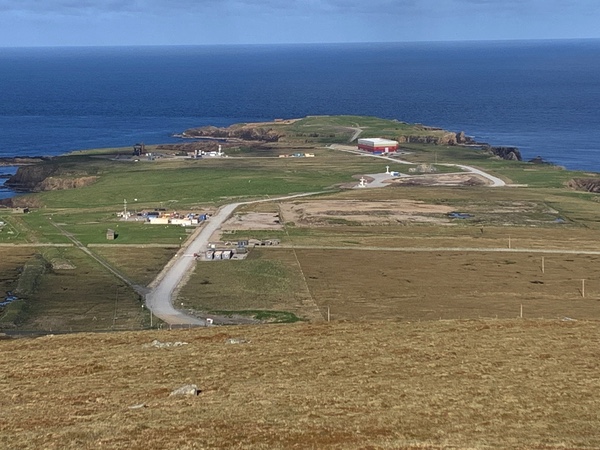Frank Strang and SaxaVord: Europe’s first fully licensed vertical launch siteby Steve Fawkes
|
| SaxaVord is almost certainly the only space launch site with a bronze age burial site, which may have been a 4,000-year-old ritual cremation cemetery. |
I was recently lucky enough to visit the site and meet the team behind SaxaVord which is located on Unst, the northern most inhabited island in the Shetland Islands, some 1,125 kilometers north of London, 600 kilometers north of Edinburgh and only 400 kilometers east of Bergen, Norway. From the pioneering days of Peenemunde launch sites have always been in remote locations for lots of reasons, including safety and security, but Unst seems particularly remote. After a flight to Sumburgh (actually two flights in my case), the drive north is punctuated by two ferry rides, and each island seems more remote than the last. The environment is beautiful.
The background to the development of SaxaVord is that in 2017 the UK government commissioned the SCEPTRE report, which used the following criteria to assess potential launch sites:
- site geography
- accessible orbits
- population
- environmental impact
- weather
- access and infrastructure
- development (economic development and political considerations)
The SCEPTRE report identified SaxaVord as the optimum site for a UK launch site, even though the logistics were considered to be “challenging”. The site has the best orbital access for polar and Sun-synchronous orbits and the location removes the need for launchers to dogleg to avoid inhabited areas, thus saving fuel. There is also minimal air traffic.
The development of SaxaVord began soon after the SCEPTRE report. Planning permission was initially denied in 2021 by Historic Environment Scotland, citing the damage to the surviving World War Two structures. In January 2022, the objection was withdrawn with Historic Environment Scotland stating, “we recognise the benefits that this development will bring to the community in Unst.” Subsequent development has been helped by the existing infrastructure that was left over from the former Royal Air Force station, which operated a critical Cold War radar system. Having closed the site in 2006, RAF re-opened the radar system as an autonomous Remote Radar Head in 2019. The buildings and facilities, including housing, had previously been sold to the developer and used as holiday and temporary accommodation.
 A bit of humor at a SaxaVord construction site. (credit: S. Fawkes) |
SaxaVord sits in a unique and beautiful environment and the spaceport is committed to sustainability. Close monitoring of bird nesting sites has demonstrated that bird life has actually increased during the construction phase. The site is installing solar panels to reduce fossil fuel usage and is planning a micro-grid, as well as electrifying transport and construction vehicles where possible. It is almost certainly the only space launch site with a bronze age burial site, which may have been a 4,000-year-old ritual cremation cemetery. The historic World War Two buildings have to be preserved, even though without the development of the spaceport they would have eventually collapsed, and in any event were never visited.
| The future for SaxaVord looks bright. It is very sad that Frank Strang won’t be here to see it. |
The site was the first of only two licenced orbital launch sites in Europe, the other being Andøya in Norway, and it is licenced for up to 30 launches a year. It has the potential for six launch pads, with one currently operational and two others under construction. Each launch pad is built to the customer specifications. The first operational pad is for Rocket Factory Augsburg. RFA has been granted a launch licence for orbital flights, the first of its kind in the UK and Europe. The RFA ONE vehicle can launch 1,300 kilograms into Sun-synchronous orbit. The company uses factory concepts, serial production, and techniques such as 3-D printing to lower costs, using conventional engineering and available equipment whereever possible. Examples include using a standard tower crane for an umbilical tower and standard industrial liquid oxygen systems. RFA’s unique technology is its Helix engine, which uses a staged combustion cycle that is more efficient than traditional open-cycle engines, resulting in 30% more payload capacity.
In May 2024, RFA conducted a successful four-engine hotfire test at SaxaVord. This was followed by an anomaly during a subsequent engine test in August, which led to the destruction of the stage. The company remains confident that they will launch payloads into orbit later this year.
As well as the launch pads, state-of-the-art tracking, and range safety systems, the site is completing the first integration building which will include fully integrated clean rooms that will allow preparation, assembly, and testing of launchers before moving them to the launch pad. As well as launch services, SaxaVord also operates a nearby ground station with several customers, including SpaceX.
SaxaVord has been developed with private capital and some government support. With growing demand for space launches, and the strategic need for UK and Europe to have their own independent launch facilities, the future for SaxaVord looks bright. It is very sad that Frank Strang won’t be here to see it.
Note: we are now moderating comments. There will be a delay in posting comments and no guarantee that all submitted comments will be posted.
